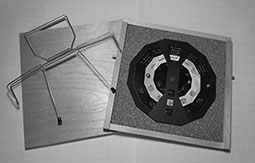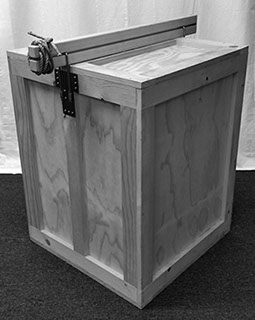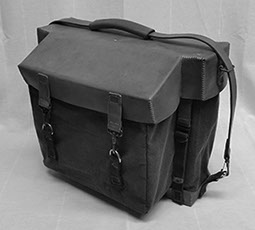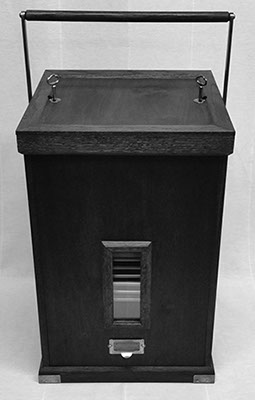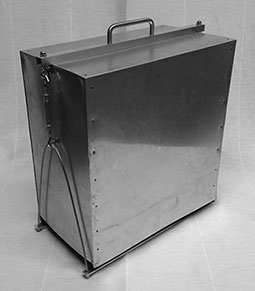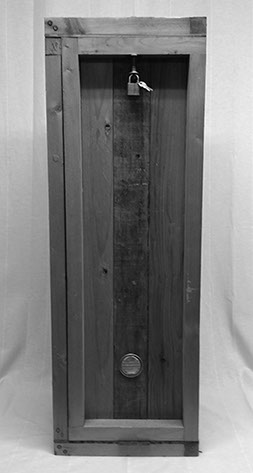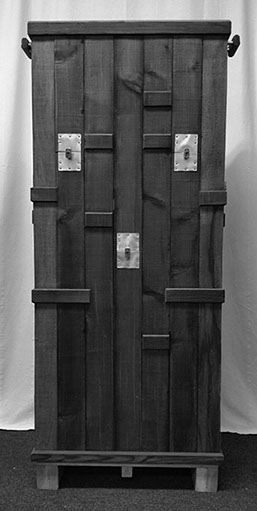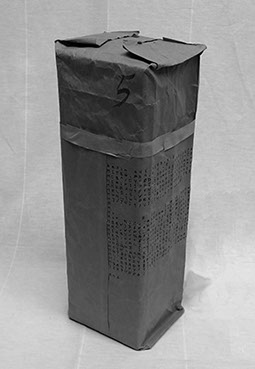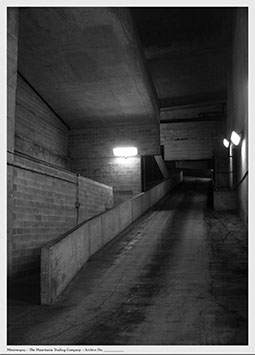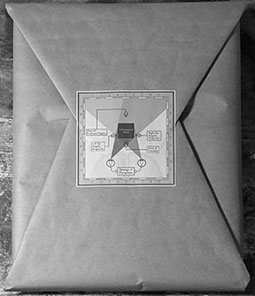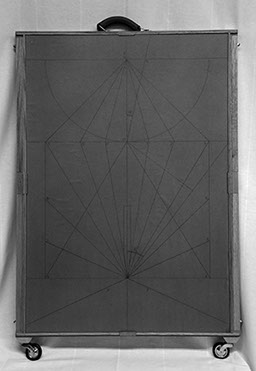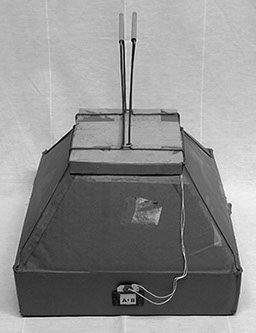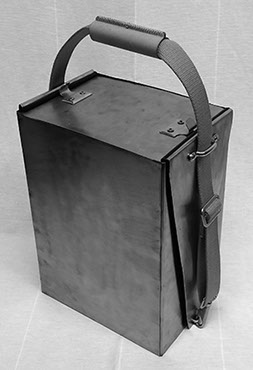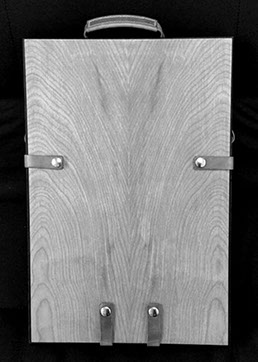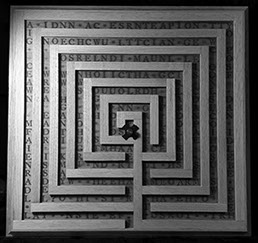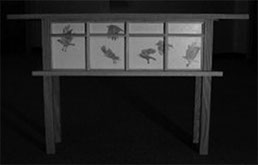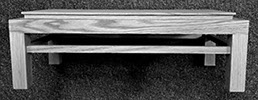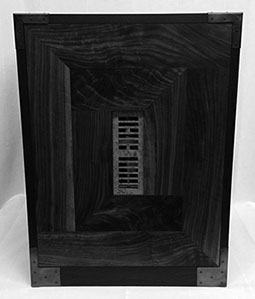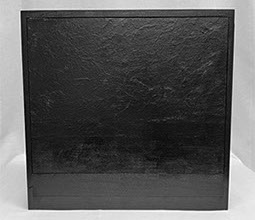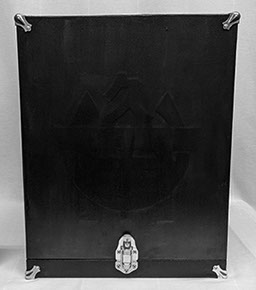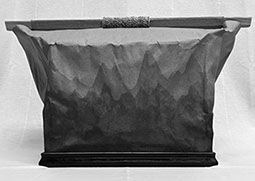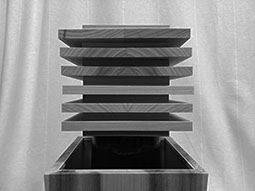(click on images for colorful details, footnotes for afterthoughts)
Title: The Artist's Statement
Creation: Santa Clara, 02016-17
Curator's Commentary:
An whimsical commentary on the expectations of the commercial art market. I've taken the ubiquitous element of the “Artist’s Statement” in a commercial art exhibit and created a subversive response. Instead of placing the exhibition visitor in the position of a passive spectator whose perceptions must be managed, the work creates a collaborative experience that encourages the viewer to be sensitized to the core themes of the work and synergize them in a composition from ukulele chords that reflect the unique perspective of the viewer.1
Size: 13 in. wide, 13 in. tall, 1.25 in. deep
Provenance:
A: Collection of Max Shain, San Francisco
Linseed oil on layered pine case with aluminum and steel tensioning handle system. (pictured above)
B: Collection of Doug Crafts, Monte Sereno
Aluminum and canvas belt hook attaching to composite fiber case with basswood accents. Display stand incorporated in design.
C: Collection of Chris Knight, San Jose
Canvas shoulder strap with metal accents. Form fitting case with layered pine and weather shielding leather flap.
Title: Reliquary for a Green Silk Kimono
Creation: Santa Clara, 02017
Curator's Commentary:
Reliquary for a Green Silk Kimono is a multi-layered sculpture incorporating at its core a kimono gifted to my mother and was displayed by her for many years. The kimono was originally purchased at a benefit for the San Jose State University Art Alumni Association, the kimono having been donated by SJSU Alumna, Katherine Levin-Lau. The kimono is of green silk with embroidered mon of a Paulownia blossom. Enveloping sculptural layers incorporate themes of contemplative environments, 18-mat tatami layouts, archival storage of textiles, traditional Japanese and western furniture design, counter-intuitive access methodologies, symbology of long-term thinking, and the impermanence of habitation.2
Media: Pine, Oak and Mixed Materials. Manufacturer documented with certificate of authenticity and stamped on interior surface: Mauritania Trading Company
Size: Closed case: 38 in. high, 27 in. wide, 27 in deep.
Provenance: Collection of the Artist
Title: Protective Casing for an Unresolved Debt
Creation: San Jose, 02020
Curator's Commentary:
A key requirement for an artwork's survival is mobility. While the exterior speaks of the luggage of a seasoned traveler, the core of this work holds an artifact imbued with restlessness and regret. Each successive layer, built around it is like a reaction to an incident on a journey. Some catalytic, others, monotonous.3
Media: Ceramic, paper, steel, copper, wood, leather, canvas, soil, ceramic.
Size: Closed case: 12 in. high, 17 in. wide, 15 in deep.
Provenance: Collection of the Artist (Previously in the collection of the late Ray Ashley)
Title: Modifiable Tesla Coil Transmitter with Encapsulated Reformat of a Broadcasted Radio Drama
Creation: Santa Clara, 02018
Curator's Commentary:
The aesthetics of antique scientific equipment are expressed in this sculptural palimpsest. In contrast to many science/art works that are often a simple minded pastiche of “sciencey” visual tropes, or the conversion of complex ideas to dull clip-art style derivatives, this work fully integrates the logical functionality of scientific tools with multi-layered visual storytelling. All components are fully functional and align with the research of the referenced era, however I have taken the extra step of incorporating subtle references to contemporary research into the Lambda-CDM model.4
Media: Oak, pine, copper, waxed cotton string, glass, rubber, Japanese kozo paper and fiber board. Manufacturer marked with documentation.
Size: 13 in. wide, 19 in. tall, 13 in. deep
Provenance: Collection of the Artist
Title: Isolation Casing for Repressed Obsession
Creation: San Jose, 2015
Curator's Commentary:
The lightly toned aluminum exterior of this case functions as a visual and tactile barrier to the nested interior. My addition of cabling and turnbuckles are to provide metaphorical and literal tension to the aesthetic. The footings of the base are steel roller balls allowing the entire sculpture to be easily moved about the surface on which it is placed. On the first interior layer a closely fitted cedar casing features a small framed black and white reproduction of Goya’s “Portrait of Juan Antonio Llorente” attached to the exterior with brass pins. But like the work of Goya, there are deeper layers with discomforting themes.5
Media: Aluminum, brass, steel, leather, cedar wood, paper and soil.
Size: 9 in. deep, 10 inches high, 13 inches wide
Provenance: Collection of the Artist
Title: Lotus Crate for Illumination in 528nm
Creation: San Jose, 02014
Curator's Commentary:
A crate for a work of art is both for storage or shipping - the state in which most art exists. A means for the armored dispersal and defense of concept and creation - key requirements for the survival of art. In this work, a robust crating system opens in a manner simulating the expanding petals of a blossoming lotus flower. The secure, tension enhanced, locking system reinforces the implications created by a guarded exterior for the delicate object held within. And deeper, behind layers of preservation and protection, something brilliant.6
Media: Pine, steel, cedar chips, glass, cotton canvas, sodium vapor.
Size: 11 in. deep, 38 in. high
Provenance: Collection of the Artist
Title: Box with Irregular Containment Seal for Deconstructed Relic of Conflict
Creation: San Jose, 02011
Curator's Commentary:
History holds what is remembered; the past, what is forgotten. Most often time itself destroys memory, other times human beings seek its eradication. This work is a memorial whose interior holds fragments of the tool of erasure. Secured by multiple locks, multiple keys, but ultimately accessible over time.7
Media: Vintage redwood, aluminum, steel, canvas, brass, glass, trace amounts of potassium nitrate.
Size: 11 in. deep, 52 in. high, 34 in. wide.
Provenance: Collection of the Artist
Title: Sarcophagus with UU-Encoded Image of Occupant Visage
Creation: San Jose, 02008
Curator's Commentary:
Taking the tradition of mummification that began in ancient Egypt, this work displays a computer hieroglyphic that retains the original appearance of the occupant. The paper exterior creates a shroud around an unseen interior sarcophagus encapsulating a tension-formed smaller encasement. That encasement is dimensioned to allow gliding movement when the object’s orientation is subtly shifted. A quirky inspiration from the patient, methodical work of Howard Carter.8
Media: Paper, corrugated fiberboard, steel, cedar, bone.
Size: 4 in. wide, 13 in. high.
Provenance: Collection of the Artist
Title: Labyrinth Access Through Parking Garage
Creation: Santa Clara, 02013
Curator's Commentary:
A perspective on experiencing a perception of reality where ambiguity is a catalyst for revealing layers to our existence that would otherwise be passed by. The harsh lighting on concrete contrasting with vistas of darkness creates a foreboding space where uncertainty sensitizes the viewer to possibilities of losing their way, and lacking direction, stumble upon what is more important than what was looked for. If there is a greater labyrinth coexistent to this reality, this would be an entrance.9
Media: Paper, oak veneer plywood, aluminum, ink, glass.
Size: 27 in. wide, 40 in. tall.
Provenance: Collection of the Artist
Title: 113 Stereographic Views of San Francisco - Early 21st Century - Volume I
Creation: Santa Clara, 02016
Curator's Commentary:
This book captures the evolving state of one of the planet’s most dynamic urban environments, San Francisco, in a 3-dimensional photo survey. Images captured at the cusp of the explosive growth in “The City” provide a unique record of how the landscape of a city can change with shocking speed. From the blossoming of the once-familiar downtown skyline to the surprising disappearance of gas stations, this volume walks the reader through quiet neighborhoods and bustling districts that in the space of a few short years have undergone tectonic upheavals. The limited edition of 20 copies include a whimsical map with photo view-points, attached lorgnette 3D viewer, archival DVD of the stereo images and a rare, original dual-image film positive from the vintage 3D camera used in the project.10
Media: Hardbound book,
Size: 13 in. high, 10 in. wide in labeled case.
Provenance: Collection of the artist and the following libraries:
The Bancroft Library - University of California, Berkeley
Prelinger Library, San Francisco
The Long Now Foundation, San Francisco
San Francisco Museum and Historical Society, San Francisco
American Institute of Architects, San Francisco
Dr. Martin Luther King, Jr. Library - California Room, San José
SPUR (San Francisco Bay Area Planning and Urban Research Association) - San Francisco
Title: Travel Case for Occulted View into Laboratory in the Shape of a Sundial
Creation: Santa Clara, 02018
Curator's Commentary:
This encapsulated photographic work is an example of my obsessive exploration of forbidden and forgotten places. In this case, a multi-layered view into an abandoned laboratory space confuses concepts of a defined location and the certainty of intended function. Where we are, and what we see, are now questions rather than statements; fulfilling the implications inherent in science and practiced in the laboratory. The physical locale of this photograph has since been destroyed. This is a memory now.11
Media: Oak, kraft paper, brass, leather, glass, paper.
Size: 44 in. high, 32 in. wide in case.
Provenance: Collection of the Artist
Title: Travel Case for Encryption Tableware
Creation: San Jose, 02009
Curator's Commentary:
My curiosity about the implications of hiddeness are on display, obliquely, in this intimate, personally scaled piece. The portable case and its content take a measure of inspiration from the design and construction of antique Japanese bento boxes. However, inside are tools for contemplation, introspection and the desire to both reveal, and occult, insights drawn from information preserved perfectly, yet unobtainably, except through patience and analysis.12
Media: Aluminum, steel, glass, wood, plastic, fiberboard.
Size: 12 in. wide, 18 in. high.
Provenance: Collection of the Artist
Title: Armored Travel Case for Reformatted Radio Broadcast with Ablative 57th Hexagram
Creation: Santa Clara, 02017
Curator's Commentary:
A visual comment on the para-military styling fetish of our current times invites the viewer to take a personal assessment of the appeal of this aesthetic. The brushed steel surface with rubber accents creates an imposing presence. This is reinforced by the cotton webbing strap with leather handle and bright metal fixtures that imply defense and control. The interior layer creates a strong emotional tension with the exterior casing through the incorporation of the 57th Hexagram of the I-Ching as a containing form for the encapsulating components of the reformatted radio broadcasts.13
Media: Steel, rubber, oak, mahogany, paper, cotton and leather.
Size: 6 in. deep, 13 in. tall, 11 in. wide.
Provenance: Collection of the Artist
Title: Travel Rigging for the Abstract to an Experiential Thesis in Consciousness Sensitization Expressed by the Ideal Labyrinth Discerned as a Parking Garage with Sequence Archetypes of The Long Way, The Chrysalis, and The Mysteries with Embedded Intersection Rendering
Creation: Santa Clara, 02020
Curator's Commentary:
Inspired by the accouterments of an expeditionary lifestyle, this compact work evokes exploration beyond immediate perceptions. The leather straps and handle highlight the warm patterns of the matched wood grain panels. Brass hardware shines and cryptic symbols hint of deeper content fragmented in sensuous paper with tones of sienna. There is much more here than meets the eye.14
Media: Leather, brass, plywood, Mulberry fibers, copper.
Size: 18 in. high, 12 in. wide.
Provenance: Collection of Tony May
Title: Inquiry on the Dreams of St. Joseph as an Alternating Cypher in the Shape of a Jericho Labyrinth
Creation: Santa Clara, 02019
Curator's Commentary:
In this keystone component of a larger installation, I have blended the experience of the spiritual with the analytical in an invitation to the inner quest. The oak wood labyrinth is inseparable from the mystic history of humanity and the hierophanic quest while the cryptographic convolutions of crimson lettering has roots in espionage and the occult. This intersection of sacred and profane mysteries becomes a conceptual gateway to a deeper insight into the consciousness of dreams and the imperative they may provoke in a receptive mind. This piece is now considered lost as it has been returned to its origin locale, a secret room with a camouflaged entrance dedicated to the Catholic Saint Joseph.15
Media: Oak, brass, red chop ink, plywood.
Size: 22 in. high, 22 in. wide.
Provenance: Concealed
Title: Storage Case for an Obsolete Art Object in the Shape of an Altar Table
Creation: San Jose, 02012
Curator's Commentary:
This sculpture reliquary in the shape of an altar table takes much of its inspiration from Japanese shoji screen design and an early 17th century screen featuring crows currently in the collection of the Seattle Asian Art Museum. Like artists of the Impressionist era such as Vincent Van Gogh and Mary Cassatt, I have felt a profound sympathy to the qualities of clarity and simplicity in traditional Japanese artwork. The sharp-edged linseed oil stained red oak is given a cool, liquid quality by the flowing water patterning of the table top wood grain. Side panels capture the flight of a crow in a light, translucent patina that reinforce its function as a catalyst for meditation.16
Media: Red oak, paper, animal-derived medium, salt, aluminum, bronze, corrugated cardboard.
Size: 38 in. wide, 22 in. high, 14 in. deep.
Provenance: Collection of Pearl & Lotus Zendo
Title: Tansu Stand with Embedded Artwork of Loss in the Context of Interrupted Travel
Creation: San Jose, 02016
Curator's Commentary:
This oak stand for a Meiji era merchant’s tansu communicates my interest in the capacity of ordinary objects to express the quality of “hiddenness”. The clean, precise and functional nature of the stand acts as a form of aesthetic camouflage and defense to the materially, and personally, vulnerability of interior contents. The stand iscrafted with Japanese inspired joinery that reinforces the idea that unity and stability are the outcome of a long and laborious process.17
Media: Red Oak, paper, brass, basswood, colored pencil.
Size: 7 in. high, 28 in. wide, 13 in. deep.
Provenance: Collection of the Artist
Title: Pavane of Tides Expressed in the Cenotaph for a Dead Princess
Creation: San Jose, 02020
Curator's Commentary:
With echoes of the Shinto Torii, this encapsulation takes the form of a low set of shelves. The oak is left in its natural shade to imply themes of humble purity. The enclosed area is delimited by a screen of wood bars whose curving gap records the rise and fall of the tides for the period of September 14th through the 15th in 02012. For the interior piece, the traditional aesthetic of mortuary furniture informs this somber work. The classical woodwork styling communicates the weight of history, while the glow of the oak finish implies reverence and the passage of time. The steel handle hardware has been patinated in the same manner as the iron components of antique Japanese tansu furniture. What is revealed inside is now ashes.18
Media: Oak, steel, leaves, clay, brass.
Size: 27 in. high, 19 in. deep, 36 in. wide.
Provenance: Collection of the Artist
Title: Repository for an Artifact of Catharsis
Creation: Santa Clara, 02022
Curator's Commentary:
The ebonized enclosure is crafted in the style of a Japanese tansu. Blued steel hardware accentuates the tones of the oiled walnut door. The locked access panel is inset with a patinated copper plate pierced with hexagrams of the i-Ching; revealed, in this instance, to the artist during the final stages of the conception of the work. The interior component provides a charged contrast to the somber casing with its natural alder framework and ink rendered silhouette of crows and pine tree over a white background. This is the only record of their existence.19
Media: Walnut, steel, paper, copper, grass cording, alder.
Size: 25 in. high, 17 in. deep, 19 in. wide.
Provenance: Collection of the Artist
Title: A Lens for the Contemplation of a Hidden Desire in the Shape of a Chinese Table Screen
Creation: Santa Clara, 02022
Curator's Commentary:
The monolithic casing is coated with unryu kozo paper which has been dyed to a deep, sumptuous blackness to enhance the dramatic fiber texture. The hardwood framing and accents retain their faint grain patterns within a seductive black satin finish. The interior component reveals a dramatic contrast of ritual purity expressed with unfinished white ash and a covering of pristine kozo paper evoking swirling clouds. All this around a mass of stone, impervious, impenetrable, and cold.20
Media: Ash, stone, unryu kozo paper, gold leaf, ebony, steel.
Size: 19 in. high, 4 in. deep, 25 in. wide.
Provenance: Collection of the Artist
Title: Portable Reliquary for Saint Gaia to be Contemplated from the Perspective of the Galactic North Pole
Creation: Santa Clara, 02022
Curator's Commentary:
The sturdy portable cabinet is inspired by the deep colors of the evening sky contrasted above the blackness of the horizon. The scintillating interior casing captures in ornate stained glass a detached perspective outside of human centered timescales. The depth and beauty of space encasing a starkly painted planet whose impasto rendering conjures the specter of death as the geography of osteology.21
Media: Paper, glass, copper, oak, poplar, coal, plastic, fabric, oil-based paint, brass, steel.
Size: 22 in. high, 16 in. deep, 16 in. wide.
Provenance: Collection of the Artist
Title: A Paper Bag Retaining the Memory of Fire Preserved in Earth Evokes Suiseki for Contemplation
Creation: Santa Clara, 02022
Curator's Commentary:
The black-washed ink implication of mist hidden distant mountain peaks finds a tactile resonance with the earthy resonance of a humble paper enclosure. Presented in the stance of traditional Japanese Suiseki, the ebonized lacquered stand elevates the aesthetic hierarchy to reinforce the fragmentary revelation of a finely crafted encapsulation sculpted in aged hardwood and steel. It retains, preserves and makes precious something so simple, yet so vital.22
Media: Paper, ink, pine, purple heart, soil, grass rope, steel, bronze.
Size: 14 in. high, 8 in. deep, 24 in. wide.
Provenance: Collection of the Artist
Title: Keystone for the Present Moment
Creation: Santa Clara, 02023
Curator's Commentary:
The aesthetics of symmetry and tension are softened in this work by the use of unfinished poplar and cotton cording. The humble materials capture hints of Shinto purity with complexity applied to the utilitarian requirements of containment and mobility. Each of the 6 rotatable crown components have dual profile options enabling the display of all possible combinations of the 64 hexagrams of the I Ching. The net work of cordage and 4 unconnected side panels hold in suspense the entire display mechanism when carried. Relaxing the tension lowers the side panels and allows the free rotation of the hexagram layers and reveals the interior foundation cylinder.23
Media: Poplar, copper, ceramic, bronze, beeswax.
Size: 10 in. deep, 25 in. tall, 15 in. wide.
Provenance: Collection of the Artist
1. I have always liked cardboard calculation tools. They are usually radial devices with one or more discs on top of the other. The discs have windows and as they are rotated, information is revealed through the window or pointed to at the edge. It could be the exposure time for a darkroom enlarger or conjugations for a word in French. This work was designed with a theme of sensitization for the experience of art. Words, symbols and phrases can open an avenue to different ways of perceiving our world. To use them as a subjective assignment to sounds I hope this would be a playful and enlightening experience.
2. Sometimes an object starts out as something delicate, rare and beautiful. Then along the passage of its life it picks up an emotional resonance. A reminder and a trigger to people and past times. Such is the case with the kimono I purchased for my mother. It spent many years displayed on the wall of her living room. But when she died, what to do with it? No one in the family was interested in having it and I wasn’t ready to simply discard it or hand it off to a thrift store, stripped of the context of its recent years. So instead I gave it a robust armor, a way to save it and carry it forward through time along with a few mementos of my mother’s love of Japanese art. Now it is encapsulated, hidden, in a small table whose strength, beauty and functionality will keep it safe until it is discovered, and hopefully, appreciated again. “Mono no aware” is phrase in Japanese that best captures this experience for me. It is one of the core concepts of my work.
3. The rough, ragged shell of the oyster conceals the soft beauty of the pearl. The smooth, shimmering surface of the pearl blankets a rasping irritant. Kill the oyster to reveal the pearl, grind away the pearl to reveal a grain of sand. At what point does curiosity only reveal regret? Or can it be sustained in a prolonged moment of anticipation; subtle sweet desire floating gently in the mind like the feel of a hummingbird hovering over the palm of your hand?
4. Some years ago I discovered several vinyl records at a San Francisco thrift store. I found that these were original recordings of radio shows from the mid-1940's. After a great deal of research I came to believe that these are the only surviving recordings of two complete radio mystery dramas. It was intriguing to me that such fragile recordings should have survived over 60 years in perfect condition and that these recordings actually existed in two places: the vinyl records and a constantly attenuating pattern of radio waves 60 light years away in space. This story, its performance, and its sharing were a unique moment in time that captured such a strong sense of ephemerality that I was inspired to express it in two sculptures. At the core of these sculptures are two books. These books are digital recordings converted to text by a binhexing program, printed on paper, and bound. The complete digital recordings have since been erased. For the "Tunable Tesla..." sculpture they are encapsulated in a functional high voltage transformer system with tunable rotating coils, glass dielectric capacitor and spark gap. The infection being that these could still be transmitted in some subtle, barely perceivable fashion through an as yet undiscovered medium. The casing is also designed to express the storage cases for scientific equipment of the era with hint of the contents of a niche in a columbarium, expressing the contradictions of rebirth and memorial.
5. Passion is either freely expressed or restrained beneath a cool exterior. What are the layers of human consciousness? What lies beneath words, gestures, and expressions? Every human being is a mystery and a palimpsest. Even the most disciplined introspection may still reveal surprises to what we see as our truest self. What did Goya see in this man when he painted his portrait? Or would a deeper appraisal reveal Goya's rendition as just a simple black and white portrayal?
6. Sometimes I find things. An ornate metal table lamp base. A street light ballast. Two objects of complementary function but for radically different uses. They should be brought together - redeemed in such a way that the excesses of each are celebrated. 16,000 Lumens. Yes, perfect for an evening at home curled up with a good book. Packaging is not a distraction. Locked and ready for transport or storage in extreme environments. Not to be taken lightly.
7. I made this with someone in mind then I changed my mind. The concept and creation came out of a fascination with the history of the Russian Revolution of 1917. A popular revolt against an oppressive and entrenched monarchy that so quickly took a wrong turn to just another type of dictatorship. All that idealism and sacrifice ended in a Siberian wasteland or the basement of the NKVD. Matryoshka for a failed revolution: resistance, erasure, exile, imprisonment - and when the vaults are opened all the tragedy is fossilized to a museum piece.
8. The written word carries images, this one literally. Early limitations to the transfer of files across the Internet required that binary files be converted to plain text files. Which means that any type of material that could be digitized could also be typed out on paper. For the ancient Egyptian, as long as the name of the deceased was written down and spoken the soul would live on, and so the long lost image of this deceased is carried forward in time as writing.
9. Sometimes I see something that is perfectly mundane, yet somehow communicates an experience of this world that reveals some greater reality. There is no objective evidence for this insight, just a sense of a harmony that far exceeds any composition of space, surface, substance and time. Like the whorls of the surface of water that implies some unseen creature moving below.
10. Rick Prelinger of the Internet Archive gives yearly talks for the Long Now Foundation. At one he spoke of how difficult it was to find historical images capturing a sense of the times that weren’t just photos of flowers, tourist spots or smiling relatives of the photographer. That inspired me to create this collection. I owned the 3d camera for many years as I had inherited it from my grandfather who was an avid photographer. So it was a great deal of fun to wander about the city taking photos of things that may likely disappear or change drastically over time - speculating about what may look unusual or trigger nostalgia in future readers of the book. I kept a small note book of every location I took photos so if the environment changed, the locale could still be identified by marks on a map in the book. Once completed, I worked to have it included in as many libraries or collections as possible. A tiny quest for immortality.
11. See Footnote 9 above on a similar experience revealed in a photograph. For the sundial table, to ‘understand’ the experience of sun, earth and equinox is fairly simple. The ‘feeling’ is more difficult to capture for an infinitesimal creature on the surface of a planetary mass spinning and rolling through a stellar vacuum, a tiny sliver of a moment made exceptional from such a limited perspective, yet it sensitizes the mind to touch lightly on the overwhelming vastness of experience
12. Even now, years later, I can still remember the title: “Codes and Secret Writing”. In grade school ordering books from Scholastic was so much fun. I had this slim book for years until it finally fell apart from constant use.
13. See footnote 4. In this sculptural palimpsest the core material is the same, but the encasement explores a different theme. This being where the ephemeral and fragile is armored for survival and fitted for travel. The steel casing and straps manifest an object that lives in a defensive posture, ready to deflect blows and escape threats. Inside is a tensioned walnut wood carapace in the form of the 57th Hexagram of the I-Ching which stands for "Gentle Penetration", a softening layer which switches the surface to one where patience and appreciation are implied after harsher defenses are stripped away.
14. The archetype symbol sequence reading from bottom to top is composed of elements printed on paper that outline what is commonly called a “false door” in Egyptian tombs. “False door” is a misnomer as this was never intended as a ruse to confuse thieves, but likely gained that name when robbers tried to smash through it to an assumed hiding place only to discover nothing but native rock behind it. The door was intended to function more as a “spirit door”, representing an entry to the afterlife and the implied new residence of the deceased. As such, family members could place food offerings at the foot of the door much the same as food may be left at the door of a friend or family member if the intent was not to disturb, but offer support. As represented in Moraga’s work it would represent a transition boundary between one level of conscious awareness and a more expanded level, not an afterlife. The symbols are part of an ongoing project that is developing a method of sensitization to Cosmos through inspirational awareness and directed insight in the context of receptive contemplation. Categories of attention for Depth and Duration in a sensitized experience of consciousness are: Archetypes of Experience, Degrees of Perception, Tools of Discernment and Catalysts of Epiphany.
15. Joseph, husband of Mary in Christian history, is an unusual person. A man who finds himself in a situation far outside of the guidance of intellect and tradition. He is presented as a person of compassion and mercy, putting aside the expectation to denounce his pregnant fiancée, he seeks only to preserve her from public condemnation, and likely execution. But then there is an intervention, a dream. A dream, which to obey, requires that he change the entire trajectory of his life. For myself, there are dreams which seem little more that the brain doing the balancing and recovery of internal chemistry - disconnected images and abrupt changes in events. But there are other dreams. Dreams which open to what seems a more real world, rich in color and depth, finely detailed objects and landscapes, relationships with complex and persistent emotions; full experiences which carry over to the waking world and seem to have revealed an entire distinct life. What does my consciousness touch on in such experiences? Is there more to my mind’s capacity for creation than what I experience when awake? Or does my sleeping mind become more receptive to a deeper world, something real, not just the confluence of neurons and synapses but part of the greater universe? What courage Joseph must have had to act on his dreams.
16. Urban crows are fascinating creatures. They seem to be an excellent judge of human intent. If you are not paying much attention to them they will allow you to get very close. If you are in a car or if there is some other physical barrier they will also allow you to get very close. However, eye contact or any other form of attention will cause them to move away. Even if you are some distance, other types of attention like pointing a stick at them will cause them to fly off. A camera with a prominent lens will have a similar effect. The birds will let out a call and fly off. Sometimes one will stay closer and repeat a warning call to alert other crows to your presence. Good crow photos require patience and subterfuge. They are familiar with humans and are rightfully suspicious of us.
17. Palimpsestual autobiography - this one may actually outlive the participants.
18. The rituals of the dead are performed for the comfort of the living. Even the smallest of creatures may be ennobled in our memories through the richness of their lives, their stoicism in suffering and their fierce resistance to death. Our experience of time is forever altered by technology. What meaning does “Dawn” or “Twilight” have in a world now fragmented and demarcated. But for most of our existence we lived time like all the other creatures. Time was a flow, sometimes swift, sometimes slow. We applied patience or urgency or simple appreciation to time; anticipation and memory flowed from future to past. Passage of Moon and Sun across the sky, the rise and fall of the ocean tide, the gradual shift of seasons, the perception of aging. In that life there are only two moments. The moment of birth and the moment of death. The moment of death for a beloved animal was Sept. 14, 02012 at 3:39pm. Low tide in the afternoon.
19. The core of this work was completed many years ago. It was then, through a process of self-discovery and seeking community and comfort, that I began fulfilling my life as an artist. At that time I was taking classes from the artist Norman Stiegelmeyer. His encouraging and welcoming attitude toward his students was so refreshing. In that environment, art became a means for healing, and as an angsty teenager, that process was very cathartic. The gradual release of intense emotions created a relaxation of mind and spirit that were critical to helping me on my pathway as an artist. The intensity of the resultant artwork from that time is implied in the layers of this work. Unseen core elements communicate themes of restraint and release, living materials acting like nuclear control rods to contain and gradually drain away corrosive obsessions. Outer layers express a calmer aesthetic, yet with small touches of the shadow to honor the core. The exterior is a balanced expression of beauty and strength, wood and metal in collaboration to protect and preserve. To penetrate to the interior, all that is required is sensitive perception and gentle persistence.
20. If meditation is to release us from the unending cycle of desire, what is our posture to be when we sit before a lens for that desire? Desire is inescapable. Focus, transmit, disperse, absorb, refract and burn. Life is desire. Blood moves by passion alone. Desire, intense and overwhelming, stares at us with a Gorgon’s face. But if Perseus guarded himself with a mirror to mute that power, how much better a lens to resolve and focus that core intensity of our existence. Then we see the Gorgon not as a monster, but the beautiful tortured beast we see in our own mirrors.
21. There is a word I have heard lately, “EcoGrief”, which goes beyond the mourning one may feel over the felling of a tree or the polluting of a stream. It is the feeling of despair when we recognize the death of entire living systems. A death we cannot even comprehend in its scope of past destroyed and future lost. As a species we have come to the point where our capacity for destruction on multiple fronts far exceeds our ability to ameliorate the damage we have done. While simultaneously we function within a delusion that we are somehow separate from our global environment, that we can function as spectators to its destruction when in reality it is a self-inflicted mutilation. A mutilation of our being that is an undeniable symptom of madness. The challenge we now face is, is this madness something we can restore to sanity, or is it intrinsic to our nature? Because the failure to achieve sanity will inevitably lead to a dead, desiccated planet.
22. Soil, wind, flames and water are not the distinct points of an elemental compass, but a catalytic cycle that flesh and mind recognize as the archetypes of mortal existence, bound together in perpetual marriage where death is not release but an ongoing probabilistic reorganization that renders memory in shifting, unbroken threads that weave unrepeating patterns from an inconceivably finite beginning to an unimaginably distant conclusion.
22. The I Ching, or Book of Changes, is one of the great works of literature. While often referred to as a tool for prophecy, I feel it is far more powerful as a means for personal transformation. By definition our lives are bound by the limitations of our experience and knowledge. The interactions of our circumscribed consciousness collectively imposes a vector of inertia in our existence that constrains our possibilities. We move forward within a spectrum and perspective that limits what we perceive as possibilities in ways we are not even aware of. Personal transformation can only happen if change can break through that bubble. The action of generating a hexagram of the I Ching is a catalyst for that transformation. To read and meditate on the revelation of an unexpected hexagram opens us to an external vector that can alter our self-inflicted trajectory.

